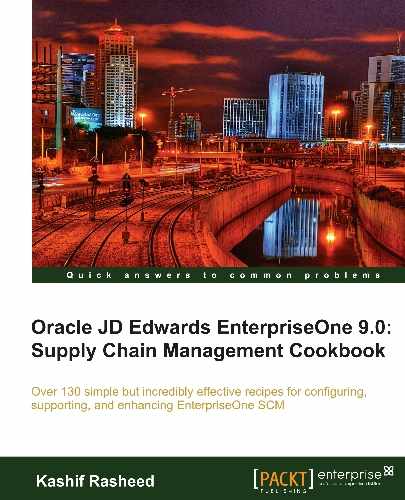This recipe discusses the creation of lot processing and defining the lot master.
- From the G41 menu, click on the Lot Control menu, and click on the arrow for accessing the processing options for Lot Master Revision.

- Access the Item Master Revision program, and then click on the Lot Processing tab.
- Enter a code from UDC 41/L that indicates the status of the lot, as shown in the following screenshot. Leaving this field blank indicates that the lot is approved. All other codes indicate that the lot is on hold.
- You can assign a different status code to each location in which a lot resides, in the Lot Status Code field on the Lot Processing tab of Item Master Revision.
- On the Lot Process tab of Item Master Revision, enter a code that indicates whether lot or serial number is assigned on the Serial Number Required field. Lot and serial number processes use the F4108 table.
- From the Basic Item Data tab on the Item Master Revision (P4101) application, enter a code that indicates the commitment method that the system uses to commit lot items from inventory, in the Commitment Data Method field.
- Enter a code that specifies whether you must attach a serial number to this item at receipt or sale for basic serial number processing, or whether memo lot information is required for advanced serial number processing. Advanced Serial Number Processing enables you to use a serial number to track an item through purchasing and sales.
- Enter the number of days that an item can remain in inventory before it expires. The system adds this number to the date that the item is received, to determine the expiration date for the item. If you do not enter a value here, you must enter an expiration date each time you receive the lot item.

Lot processing enables you to manage and maintain information about groups of items. You can view current information about each lot, such as the quantity of available items, and the transactions that have affected the lot. Lot control is beneficial for identifying groups of items that are components of a final product.
For example, if you assign lot numbers to both hard drives and to desktop computers that are assembled using the hard drive, you can identify the lot number for the hard drives that were used to build a specific desktop computer. If you later find that a particular lot of hard drives are defective, you can immediately identify and recall all desktop computers that were assembled with the defective hard drive. A lot usually contains one type of item, but you can set up system constants to enable different types of items in the same lot. If a lot contains different items, the system maintains lot information for each lot number and item combination. You can also set up system constants to restrict a lot to one type of item and still enable that lot to exist in multiple warehouses.
You can set up system constants to process a lot that contains only one type of item, but with quantities located in multiple warehouses. For example, say Lot 234 consists of one type of item: bicycle tires. In addition, Warehouse A represents the bulk warehouse, where the majority of the tires are stored. However, Warehouses B and C receive partial quantities of the same item, so that Warehouse A has adequate space. When you receive the tires at warehouses B and C, you can assign them to Lot 234 and track them through the unique lot number.

- Setting up branch/plant constants in Chapter 1,Inventory Management
